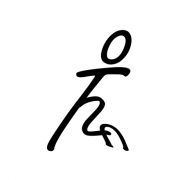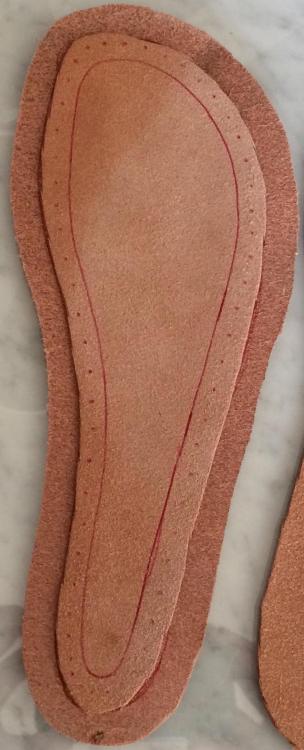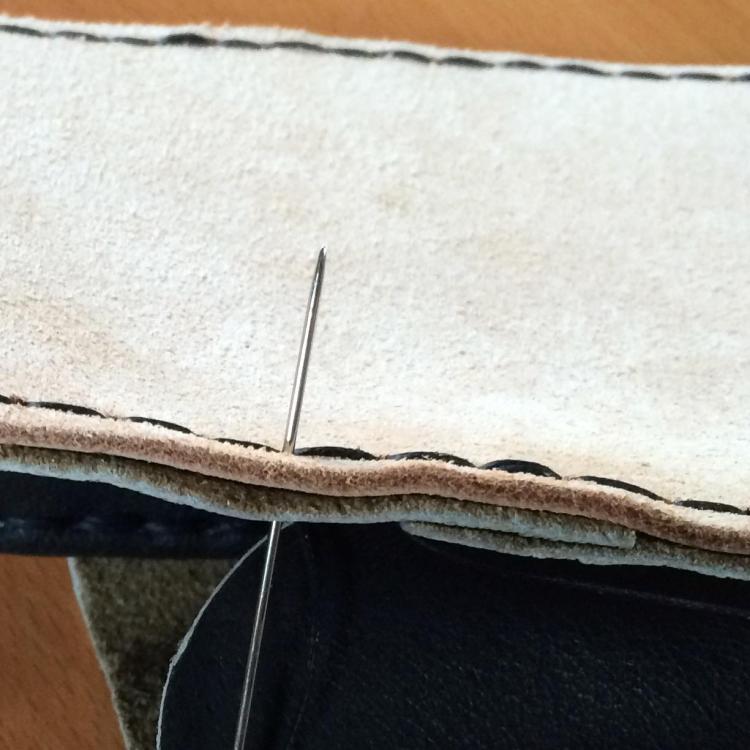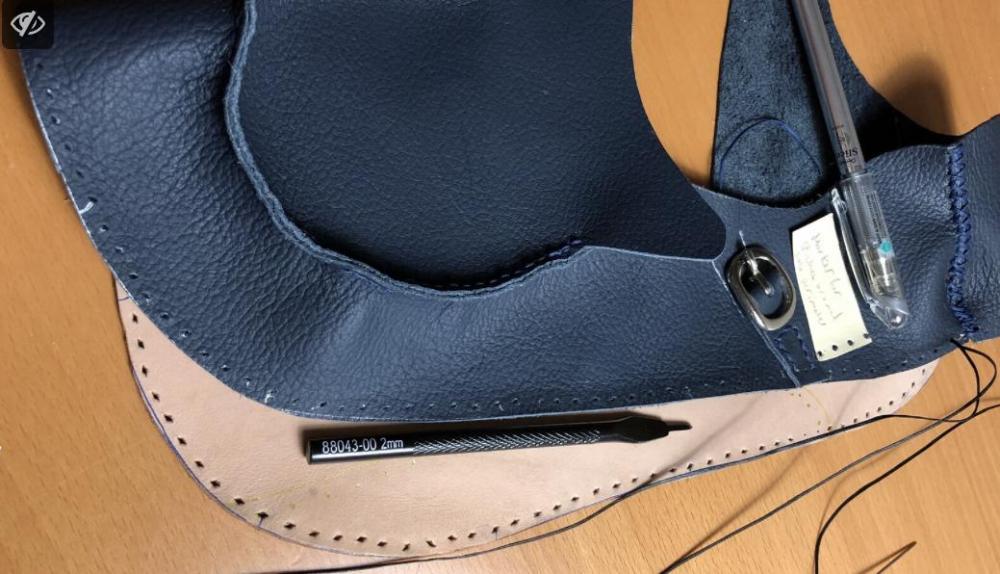-
Posts
23 -
Joined
-
Last visited
Contact Methods
-
Website URL
https://tozafoot.com
Profile Information
-
Location
Mid-Atlantic USA
-
Interests
Shoemaking, minimalist footwear, barefoot shoes
LW Info
-
How did you find leatherworker.net?
DuckDuckGo
Recent Profile Visitors
The recent visitors block is disabled and is not being shown to other users.
tozafoot's Achievements

Member (2/4)
-

BOOT TOE BOX REPAIR QUESTION
tozafoot replied to Drummist's topic in Shoes, Boots, Sandals and Moccassins
I have used a small marble pestle to push out slightly dented toe boxes: can hold the pestle in place with one hand and hit the outside of the toe shape lightly with a small hammer (peen) to smooth out creases in the leather. Not sure about using heat to restore shape: I guess it depends what was used to make the rigid toe shape in the first place. When I make footwear with toe boxes, I soak veg-tan cowhide (~5oz) for several hours before pulling it into place on the last and nailing it on. No heat involved at all, only water, -
How much are you asking for this machine (including the head, table and servo motor), @leatherpasion? When did you buy it? (I.e. how old is it?) Do you know anything about how the warranty might transfer to another owner, given its “unused” condition? Thanks for clarifying.
- 2 replies
-
- techsew 2750
- industrial
-
(and 1 more)
Tagged with:
-
If you don’t want to go to the expense of lasts, or are worried that you won’t be able to find ones that suit your foot, you can always make footwear without using lasts. Cling wrap (or cling film), masking tape or duct tape, an indelible pen, and thin card are all you need to make a pattern.
-
I’ve not ordered anything from them yet, but recently came across this site https://podohub.com/ that sells foot-shaped lasts (I.e. without strongly tapered toes and high heel lifts) and a few other shoemaking things. I believe they ship internationally. For hand tools, there are many options. If you don’t plan to make shoes for a living, for basic cutting, skiving, punching, gluing you might find much of what you need from Tandy Leather or Etsy. For higher quality tools (e.g. skiving knives) and more specialist shoemaking stuff (e.g. Hirschkleber glue) try Sorrell Notions and Findings ; she also sells more conventionally-shaped lasts. Note, you don’t need to have lasts to start making shoes, boots or sandals. Some of the most comfortable ones I’ve made have been unlasted. The key thing is to get the pattern absolutely right — which is much, much harder than it might seem. In fact, for me, pattern-making is hands down the most difficult part of shoemaking.
-
Thanks, ScottEnglish, that Podohub site looks very interesting! How great that there are increasing resources for people who want to make foot-shaped footwear.
-
You can make minor adjustments to lasts, shaving bits off here and there, or adding expoxy putty or gluing on bits of veg tan leather to increase the dimensions. Or you could get a custom pair of lasts made to your measurements: Springline Lasts do this, I believe. It’s not easy to find lasts that have zero heel lift, and wide toes, and lack of toe spring. Let me know if you do! Something else to be aware of: once feet are not crammed into footwear with tapering toes, stiff soles and raised heels, over months to years they will change shape… spreading, lengthening, and maybe getting higher in the arch. Not surprising, as muscles and tendons begin to work as they were meant to, maybe for the first time in decades. But it does mean that your first pair of lasts may not last (haha) you a long time. I have been making my own footwear for seven years now, and I am probably going to have to buy new lasts this year if I want to keep making lasted shoes.
-
Thank you, kgg, I have been relying on that very useful needle/thread chart for weeks, while I have been drawing up a shortlist of possible machines. From your comment here, I guess the "minimum" is a more important part of the "minimum needle size" column heading than I had previously realized (I would have looked at the chart and decided that a V92 thread required a #19 needle...). For my uppers, I think V92 will be fine, but I do wonder whether it will be strong enough for stitching down uppers to soles, and for sewing sole components to each other. Yes, thank you, I have had conversations with helpful folks at Artisan (Chester) and TechSew (Ron) about each of these machines. As far as sewing tight curves, and close to edges, no question either machine would be a good choice. Regarding thickness of what can be sewn, and whether or not the machines would work for what I want: it seems that the number of layers matters, as well as the type of leather, total thickness and needle size/type (I believe these machines both take 135 x 8 needles, the TechSew 830 up to size #22 and the Artisan 4618LBB up to size #24). The TechSew 830 can be fitted with a speed reducer before shipping; the Artisan doesn't have that option: apparently the (specific to Artisan) servo motors are highly controllable making a speed reducer less necessary. Much to think about. If anyone reading this has one of these machines (Artisan 4618 or TechSew 830), I would so appreciate it if you could let me know what types and thickness of leather you are successfully sewing with it!
-

New book by Harry Rogers “Making Handmade Shoes”
tozafoot replied to tozafoot's topic in Shoes, Boots, Sandals and Moccassins
Hi ScottEnglish, if you are interested in making men’s formal dress shoes, in case you haven’t already come across it, here’s a blog by someone who is self-taught and making some very impressive shoes https://secretcobbler.com Many pictures of various designs in different stages of construction. Also contains useful links to resources in the UK. -
While researching sewing machines recently, I came across some YouTube videos by Harry Rogers… and it turns out he has just (Nov 2022) published a step-by-step guide to making formal shoes with welts and low heels. I bought a copy and thought I’d mention it here, because there are not many in-print illustrated guides to the traditional process (e.g. he uses wood pegs to fix the rands in place). If you don’t mind using contact adhesives (e.g. PVA white glue), and you want to make shoes with raised heels and stiff soles (including shanks), the book has many detailed photos of the process, together with written instructions and tips. Early chapters cover useful information about tool selection and maintenance (sharpening!), and the basics of leather selection. Basically, it brings together a lot of relevant information that otherwise you would have to source from many different places. In the US, it seems to be on sale at Amazon at the moment. Ref: Rogers, Harry (2022) “Making Handmade Shoes: A Step-by-Step Guide”. Bucklehurst Publishing. ISBN 9798361681792
-

3 oz. vegetable tanned goatskin
tozafoot replied to ScottEnglish's topic in Shoes, Boots, Sandals and Moccassins
Yes, experimented with it, and wouldn’t recommend using it: it’s very stretchy. -
Having been hand sewing footwear for 7 years, I’m researching my first sewing machine. Many thanks to folks on this forum for all the excellent advice that helps newbies like me learn. I make minimalist shoes, boots and sandals with thin, very flexible soles (no raised heels). I am now looking for a machine that ideally will let me: Assemble uppers: sewing two or three layers of 2-6oz chrome tan or very soft veg tan leather. Up to 6mm (1/4") in total thickness, but mostly around ~3-4mm (1/8" to 5/32") Assemble flat veg tan soles: sewing two flat pieces of 4-8oz fairly dense but flexible veg tan together. See photo 1 below for an example. Total thickness is typically ~3mm (=1/8" or 8oz) to 6mm (= 1/4" or 16oz) “Stitch down” uppers to soles: I stitch one to three layers of 2-4oz chrome tan or soft veg tan upper “down” flat around the perimeter of a flexible 4-8oz veg-tan sole. See photo 2 below for an example. Total thickness is typically ~3mm (=1/8" or 8oz) to 6.5mm (=1/4" or 16 oz). This is similar to what I think Jarakoko is doing. Since I often want to stitch close to the edge of the leather on tight curves, I figure a (driven) roller foot machine might be better for me than one with a walking foot such as a Juki 1341 clone. I have been considering whether an inline walking foot would work, but I am not convinced it will, because there simply won’t be enough material in line behind the needle on some of the tightest curves I want to sew. Most of what I stitch is 3-6mm total thickness, which many of these post-bed machines should be able to cope with according to their posted specs. But it seems there are relatively few capable of sewing with V138 or V207 thread; many seem to max out at V92. I would like to use V138 or even V207 thread at times, so I have been considering: The TechSew 830: can apparently take #22 needles and V138 thread. The TechSew site says it can sew up to 3/8” (9.5mm) thickness. The Artisan 4618LBB: Artisan apparently modify the normal 4618 (which appears to have the same instruction manual as the Consew 701) to take up to #23 or #24 needles and V207 thread. But the total thickness of material it can cope with under the roller foot is only 6mm, or 1/4”. My question is: can I sew up to 6mm (= 1/4" or 16oz) total thickness of flexible but fairly dense veg tan leather on either of these machines, using a #22 needle and V138 thread? If not, what is the maximum thickness I might expect to be able to sew? Sadly I haven’t found anywhere near me (NJ, southern NY, eastern PA) to try out either of these machines in person, so I’d be very grateful for the experience of folks on this forum as to what, in practice, they are capable of. Many thanks for any advice you can give!
-
I’m not sure whether chrome tanned leather stiffens enough after drying from a thorough soaking to act as a decent stiffener… never tried it. Re foot-shaped shoes with no heels and flexible soles. Nice to “meet” a fellow traveler! It amazes me that most of the footwear for sale in “the West” will deform your feet and ruin your health, but hardly anyone seems to care. Have you come across the Natural Footgear website ? They have some interesting articles about the importance of roomy toes, flexible soles and lack of heels, and some interesting photos and videos (e.g. of blood flow in feet with restricted and unrestricted toe room). They also sell footwear, although many of the brands they carry don’t have enough toe room IMO. And most of them are non- fixable once the soles go through. I did manage to resole some SoftStar Primal RunAmocs, though — those and Unshoes Uintas are the only thing I wear these days that I haven’t made myself. Re my blog. I really should post some more photo essays of things I’ve made in the last couple of years. It does take a time to put them together though, almost as long as making the footwear! But now that I’ve made several pairs of welted shoes, some sandals, several kinds of unlasted shoe, I don’t feel as much need to chronicle stuff for myself, because I now know the ropes. Do you post photos / methods of the footwear you’re making @ScottEnglish?
-

For footwear, do I want a TechSew 830, or … ?
tozafoot replied to tozafoot's topic in Leather Sewing Machines
I have not tried that technique yet. For my unlasted shoes I’ve been doing a simple stitchdown / sew-down of upper to a sole that acts as insole and outsole (e.g. see photo below): I could easily do this with a cylinder or post bed machine and a roller foot, probably with a walking foot (with some practice!). For my lasted shoes I have used welts, i.e. tack upper + liner and insole to a last then sew on a welt through all of these (I would not need a machine for this), then sew the welt to an outsole (Photos of the process in this blog post) I I might want to try using a machine for this latter step, although it may not work, because when I sew by hand I punch holes very close to the upper, and I might not be able to get close enough with a machine I talked to Richard at Industrial Sewing Machine Man in NJ today. He mentioned that dual roller machines with reverse might be more prone to jamming on reverse than simpler roller machines or walking foot machines… something else to consider. Having done some more research I am tending towards a Cobra Class 26. If anyone in NJ / eastern PA / southern NY is looking to sell a used one, let me know! -

For footwear, do I want a TechSew 830, or … ?
tozafoot replied to tozafoot's topic in Leather Sewing Machines
Thank you very much for your thoughts, @kgg and @ljk. Yes, I think that would be ideal. Now to find a local (NJ/NYC/PA) dealer with all three types in stock for me to "test drive" (the post-bed with roller foot, the 1341 class and the 441 class cylinder bed)... By googling, I did find a dealer in Asbury Park NJ ("Industrial Sewing Machine Man"), but all other suggestions also gratefully received! A treadle would be great, but I am not sure how to get hold of one of these machines other than by looking on Craigslist, eBay and other secondhand sales places. Two things meant these didn't go from my long-list to my short-list: Each needs a hand to operate the lever, but I think I will need both my hands to steer the leather without slipping; so a treadle, or a servo motor controlled by knee or foot paddles would be better. I thought I saw a few people on this forum saying they were not great for sewing very thin leathers, and sometimes my uppers / liners are pretty thin (2-3oz total at the seam)... but maybe I misunderstood that "CLSP" = Chinese Leather Shoe Patcher?... Sorry, not sure what the abbreviation refers to. It's great to "meet" someone else who makes their own shoes! [Edit: typos... never see them in the draft ] -
I would really appreciate some expert thoughts on what kind of machine I should invest in for making footwear, please. I’ve spent hours (re)reading many excellent threads on this forum to try to learn about machines, needles and thread (all new to me). But I am having trouble narrowing down my options. I’ve been making footwear since 2015, mostly by hand. I make both lasted and unlasted shoes (see my website at https://tozafoot.com and my Mastodon feed at https://ohai.social/@tozafoot). Since 2020, I have been concentrating on unlasted / stitchdown types, because it’s much easier to end up with a sole that’s very flexible, and to vary the toe shape without paying for an expensive last. I’m not a complete sewing machine novice, but the thought of having to set up and maintain a complicated machine rather daunts me. I’ve used (and own) a domestic machine for making things like curtains, pillow covers, aprons, some clothes. And I have been on a few taught courses where I have used other people’s (already set up!) industrial machines for sewing a very limited number of footwear uppers: I have used flat beds with presser feet, and cylinder and post beds with roller feet. So I am familiar with things like stitch length and tensioning, but I’ve never had to swap out thread sizes, needle sizes, presser feet types or footplates. For my hand sewing I've been using Ritza (Tiger) thread: 0.8mm for uppers and 1mm for attaching uppers to soles. Stitch lengths have been 2-4mm for uppers, and 6-10mm for attaching uppers to soles. I wouldn’t want a machine to do any stitch length larger than 10mm, and probably 2-8mm would be ideal. From my very limited experience and understanding (and apologies if I am getting some of the terminology wrong): I think I prefer a roller foot to a walking foot because when I used a roller foot, I found it easier to stitch close to the edges while still seeing what I was doing, and to make tight curves… but maybe I’m wrong? I don’t think I am too bothered about whether it is a post or cylinder machine, although post machines are often used for footwear uppers, and there must be a reason for that! I believe I need a machine that will sew 2-20oz thickness, but mostly 3-14oz (=1-6mm). For example: a 3oz upper to a 2oz lining; adding decoration and straps could increase upper thickness to ~8oz in places; the uppers then need to be sewn to a 5-8 oz sole. I think this means that ideally I need #46 thread (#14 needles) to #277 thread (#25 needles), but I could probably just about manage with #69 thread to #138 thread (especially if I sew two parallel stitch lines with the latter when I need a very strong seam). In an ideal world I would have a treadle-powered machine, because I’m kind of old-fashioned, and get negative joy from having to set up and deal with electric motors and speed reducers etc. And I loved using an old treadle machine in someone else's workshop. But I recognize that realistically, a servo motor with a speed reducer may be the way to go. I think I may need some support in configuring and learning how to use the machine, so buying from a good dealer (rather than, say, Craigslist) may be useful for troubleshooting. My budget is $2K to $3K (or maybe a bit over for a super machine, especially if it will have good resale value). I can’t currently see how to turn my hobby into a business, so any machine I get would likely be used for 8-20hr a week. Based on this, I have identified the following machines that might work for me: TechSew 830. Post bed, with dual drive roller. A bit on the pricy side at around $3.1K including tax, but I could spring for this if it really is the best option and will have reasonable resale value. My main concern about this is that its max thread size is #138. Also, its max stitch length is 5mm, and in an ideal world I would have slightly longer stitches at times. Consew 710 UX: roller foot, post bed, but again only uses up to #138 thread. Class 26 Cobra or TechSew 2750. These would handle heavier thread (up to #207), and have longer max stitch length (8mm), but will they still be OK for the thinnest uppers I need to stitch (~2oz)? A Cowboy 3200 fitted with the narrow needle plate that RockyAussie developed, so it can sew with much thinner leathers and closer to the edge than the factory defaults allow. This would sew #69 to #346 thread (perfect), and has a 12mm maximum stitch length, but the arm diameter is pretty large, and I am still not sure about the walking foot. Are there any more that should be on this list? Should I knock any off? Is there anything else I should be looking for? Any pros and cons of the various models I should particularly consider? What should I ask a dealer when I enquire about these? Thank you for any advice you can provide!





